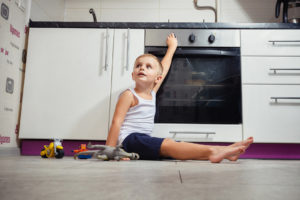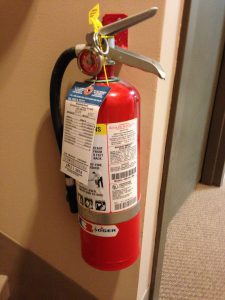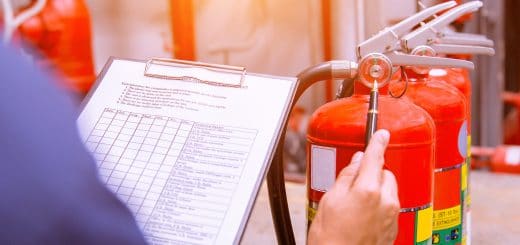How to Childproof Your Home: Protecting Them from Fire Hazards
Children are curious little humans, reaching out to everyday items that fascinate them and poking into crevices with sheer inquisitiveness. Playful actions like these are a potential danger to children and the home overall. Electrical sockets can electrocute, and household fires can ignite when a child fiddles with a single match. Aside from these household particulars, scalding liquids and water are common causes of burn accidents in children. As is evident, the presence of fire hazards is huge in a typical home with children.

Make sure kids are supervised at all times to prevent the risk of burns and fires in the home.
Parents have the responsibility to protect their children from the dangers lurking in every electrical outlet, each burning stove and a crackling fireplace, among other risky areas in the home. Childproofing the home is a simple task, yet it requires thorough preparation and thought. Following are several tried and true methods to protect youngsters from fire hazards:
In the Kitchen
Moms and dads enjoy the company of their young child while preparing a meal in the kitchen. When assuming the role of family chef, keep all pot handles turned inward toward the rear of the stove. Twist pot handles so they are out of sight, and the boiling contents inside the vessel will have no chance to spill over the child if he or she attempts to grab it.
Use the backburners of the stove whenever possible to ensure the child has no access to the hot burners. Also place oven mitts, towels and other flammable items out of reach of a child’s grasp. By doing so, kids will have zero opportunity to unwittingly move these materials toward a heat source.
A highchair or similar safe spot keeps the youngster out of harm’s way while a parent is cooking with a dangerous mix of fire and boiling water. When giving a child a bottle, be careful to avoid heating baby bottles in the microwave, which heats the contents unevenly. Also ensure any microwaved food or other beverages served to the child are warm—not scalding hot.
Check out this article from Mom Loves Best for more about babyproofing your kitchen.
Within Storage Areas
 Flammable liquids should be carefully stored in a secure area, out of children’s reach and away from flames. The tiniest match left carelessly in sight can invite a child to play and spark a household fire. Parents are urged to store matches and lighters in locked spaces, such as cabinets and drawers. Snuff out candles when adults are no longer in the room.
Flammable liquids should be carefully stored in a secure area, out of children’s reach and away from flames. The tiniest match left carelessly in sight can invite a child to play and spark a household fire. Parents are urged to store matches and lighters in locked spaces, such as cabinets and drawers. Snuff out candles when adults are no longer in the room.
Common household items, like petrol, paraffin, hot irons and lamps, can kindle a fire in the hands of children or lead to a nasty series of burns. Both the kids and the home remain safe when items like these are out of youngsters’ reach.
In the Bedroom
Sustain the comfort and avoid the dangers in a child’s bedroom. In the colder winter months, maintain at least three feet of space between the space heater and bedding and window curtains. Keep the children a far distance from the space heater and monitor the heater when it is in use. Nightlights, too, should never touch fabrics, like bedsheets and curtains.
Electrical sockets incite curiosity in children, prompting them to poke inside with their fingers or an object. Rather than risk possible dangers, shield the outlets with child-safety covers.
Synthetic fabrics can ignite easily. When dressing a child in pajamas, choose fabrics, like treated cotton, that are labeled as flame-retardant. Also select snug bedtime wear for the kids rather than loose-fitting pajamas.
Electrical toys should be inspected regularly. Toys that spark, emit odors or feel hot should be tossed.
Fit the child’s bedroom with a functional smoke detector. Monthly smoke alarm tests should be performed, and batteries changed biannually.
Around the Home
 Loose, frayed, or old electrical cords should be tucked away, covered, or removed to ensure the wires do not fall into the hands of children innocently hunting amusement.
Loose, frayed, or old electrical cords should be tucked away, covered, or removed to ensure the wires do not fall into the hands of children innocently hunting amusement.
Fire extinguishers should be a central part of every home. Keep a working fire extinguisher on each level of the home, near an exit and hinged onto a wall out of a child’s reach. Know how to properly use the fire extinguisher.
Install a guard door if a fireplace is a fixture in the home. The guard door prevents a youngster from getting dangerously close to dancing flames. Teach children to never put anything into a lit fireplace.
Teach Invaluable Lessons
Give children a valuable life lesson in how to act when fire catches their clothing. The simple teaching of stop, drop, and roll saves lives. Stopping immediately upon noticing a flame, dropping to the ground with hands covering the face and rolling on the floor will extinguish the flames. Instruct the children when and how to call 911.
Formulate an Evacuation Plan
With the family, practice a fire evacuation plan. The evacuation plan should outline two ways to exit any given room; the plan should illustrate how children should avoid breathing in smoke in a burning building by crawling along the floor; and, the plan will indicate a safe, familiar meeting place outside if the home is engulfed in flames.
The above guidelines to childproof the home have a major impact on preventing damaging fires. In the event a fire does blaze within a residence, proper steps should be taken to keep the ruin from spreading. The fire’s byproduct of soot and smoke can permanently lodge into certain surfaces, even once the fire is extinguished.
Fire Damage Restoration
In the immediate aftermath of a fire, contact a reputable fire damage restoration company, such as RestorationMaster, to inhibit the destruction. The skilled technicians employ advanced and safe chemical cleaning solutions to remove soot and smoke residues. Structural damage is repaired during the restoration process, as well.
The specialists at RestorationMaster work with incredible speed to mitigate the damage caused by soot and smoke. The team’s efforts include essential pre-cleaning to limit the harsh effects of the house fire.
RestorationMaster reliably serves the residential and business communities of Perkasie, PA. The fire damage restoration team stands by 24 hours a day to swiftly respond to emergencies.












